Culture of Assam
Assam - the very mention of this word brings to one’s mind the delightful blend of culture, heritage, faiths and beliefs of the innumerous ethnic tribes and sub-tribes residing in this region. The culture and tradition of the state, its music, dance and literature are all interwoven into the social fabric and cross all barriers of caste, creed and religion. In fact, a mention of the rich tradition of the state, without referring to the diverse lifestyle, arts-crafts, fairs and festival of the people residing therein, would be as good as incomplete.
Assam has the largest number of tribes or races in the whole of India. The main communities of the region include the Aryans and the non-Aryans i.e. Mongoloids and Indo-Iranians. Apart from that, Bodos (or Kachari), Karbi, Kosh-Rajbanshi, Miri, Mishimi and Rabha are the other tribes that have been infused in the rich cultural tapestry of Assam. All these ethnic tribes have their own distinct pattern of dressing, language, festivals, tradition and heritage. In spite of such variations, the people here live in perfect peace and harmony - a unique trait seen only in this part of the world.
The diversified culture of Assam can also be attributed to the influence of the different dynasties and empires that resided in the region in different eras. Around 45 different languages are spoken by different ethnic communities within Assam. However, the principal language of the state is Assamese, regarded as the lingua franca of the entire northeast India. The major festival in Assam is Bihu, which is celebrated by all, irrespective of their caste and creed. Some other festivals celebrated with pomp and grandeur within the state are the Baikhu and Pharkantis of the Rabhas, Ali- ai ligang by the Misings and the Me-dum-me-phi by the Ahoms.
The cultural elements of Assam are below:
The Assamese adorn very simple dresses, and mostly hand loomed. The women wear motif-rich Mekhela Chador or Riha- Mekhela. The men wear 'suria' or 'dhoti', and over it, they drape a chadar known as 'Seleng'. Gamosa is an indispensable part of almost all socio-religious ceremonies in Assam. It is derived from the Kamrupi word 'Gaamasa' (gaama+chadar) which was used to cover the Bhagavad Purana at the altar. It is considered as an act of purification and used to clean the body after bath. It looks like a white rectangular piece of cloth along with a red border on three sides and woven motifs on the fourth. Assamese men wear the dhoti-gamosa which is their traditional dress. Bihu dancers wrap it around the head, and it is often used to cover the altar at the prayer hall or the scriptures. The other things like Tamul paan and Xorai also important symbols. The former is considered as offers of devotion whereas latter is a bell used for container medium. |
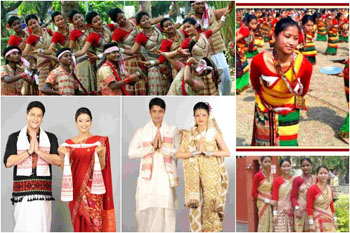 |
Home to a many ethnic groups and diverse cultures, Assam is rich in folk music which in turn has influenced the growth of a modern idiom. Some popular artistes who blend traditional and modern music are Jyoti Prasad Agarwala, Bishnuprasad Rabha, Bhupen Hazarika, Nirmalendu and Utpalendu Choudhury, Pratima Barua Pandey, Luit Konwar Rudra Baruah, Parvati Prasad Baruva, Jayanta Hazarika, Khagen Mahanta. The new generation singers are Zubeen Garg, Angaraag Mahanta, Kalpana Patowary, Joi Barua, Jitul Sonowal and Manoj Borah. The capital Guwahati has become the country's hub for rock music along with Shillong. Of late, a number of rock bands were formed to showcase their talents. . |
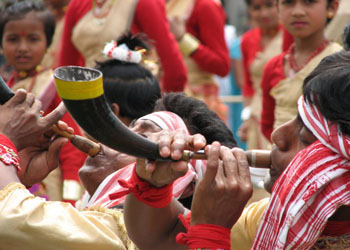 |
Cane and bamboo craft, bell metal, brass craft, silk and cotton weaving, toy and mask making, pottery and terracotta work, wood craft, jewellery making and musical instruments making have been the traditional occupation for thousands of years. Assam also excelled in making boats, traditional guns and gunpowder, colours and paints, articles of lac, traditional building materials and utilities from iron. Cane and bamboo craft provide the most commonly used utilities in daily life from household furniture to weaving accessories and musical instruments to construction materials. Hajo and Sarthebari (Xorthebaary) are the important centres of bell-metal and brass crafts. Assam is known for its prestigious silk item called muga, this natural golden silk is exclusive only to this region. While Sualkuchi is the traditional hub for silk industry, all rural households in Brahmaputra Valley produce silk garments with fine embroidery works. . |
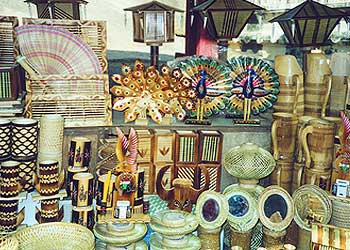 |
Assamese dishes are said to be less spicy than any other Indian dishes. Assamese are mostly non-vegetarian, and their staple diet is rice. Fish, chicken, duck and pigeon and pork are widely eaten and quite popular. Fish curry is another favourite which is prepared as a sour dish called Machor tenga. Baked fish wrapped in leaves with white mustard paste is a popular delicacy called Patot diya mas where 'pat' means leaf in Assamese. Dried fish is a traditional tribal cuisine. Mutton, duck pigeon and fowl are many of the varieties of meat preparations. The variance of rice are produced and prepared like Cheera (flattened rice), akhoi (parched paddy grain), muri (puffed rice), pithguri (pound rice), sandoh guri (fried, pound rice), komal saul and bora saul.
The presence of traditional 'detoxifying' appetizers like Khar is prepared by burning the stem of the banana tree. It has a specific flavor which is soothing for the tummy. People who have a weakness for sweet won't be disheartened one bit as the Assamese dish is incomplete without sweets and one of its specialties called pitha is made from rice. Til pitha (moulded sticky rice cake with black sesame filling), ghila pitha (fried rice cakes), sunga pitha (rice cake baked inside whole bamboo pieces), narikolor laaru (sweet coconut balls) and kol pitha (banana pancakes) are some of these delicacies of the Assamese cuisine. |
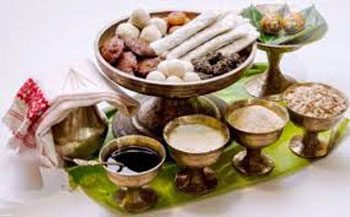 |
Bihu is the most celebrated festival in Assam. It is a series of three important festivals to mark the seasons and is a significant pointer to a farmer's life in a calendar year. All communities take part in Bihus as they are non-religious in character. Three Bihus are celebrated in all -- rongali to usher in spring and the beginning of the sowing season; kongali, the barren bihu when the fields are lush with crops but the barns are empty; and the bhogali, the Thanksgiving Day when the crops are harvested and the barns are full. Rongali, kongali and bhogali bihus are also known as bohag, kati and magh bihus respectively. The day before the each bihu is known as uruka. There are unique features of each bihu. The first day of rongali bihu is called Goru bihu (the bihu of the cows). On this day the cows are taken to the nearby rivers or ponds to be bathed with special care. Traditionally, cows are respected as sacred animals by the people of Assam. Bihu songs and dance are associated to rongali bihu. Baisagu (or Bwisagu) is a seasonal festival of the Bodos of Assam and it denotes the start of the New Year. Baisagu is a Boro word that originated from the word "Baisa" which means year or age, and "Agu" means start. Ali-Ai-Ligang is the spring festival of the Mising people of Assam. The name of the festival is derived from three terms -- Ali (root and seed), Ai (fruit) and Ligang (to sow). Bohuwa dance is performed during the festival of Sonowal Kacharis in Assam. |
 |
Ojapali, Devdasi, and Satriya are the major dancing styles of Assam. Oja or the lead dancer narrates a mythological story along with the fusion of dance and acting. It is of three types - biyah-gowa that presents Mahabharata stories with the rhythmic use of feet, sukananni which celebrate the worship of snake goddess Manasa, and ramayani is based on the Assamese version of Ramayana. Satriya, developed by Sankardeva. Devadasi - deva-nati or nati nas is a conventional temple dance that is performed by unmarried women who submitted their lives to the presiding deity.
The dances of the Bodos are associated with the Kherai Puja festival where Bagurumba dance is the most popular. Other folk dances are incomplete without the Jhumur performed by the Adivasis which is a synchronized dance of boys and girls to the sounds of drums and flute. |
 |
The jewellery is usually hand-made, and the designs depict floral and fauna. The people are keen on wearing a beautiful and unique style of ornaments made of gold and silver and varieties of jewels. The jewellery are simple and decorated with ruby or mina. The traditional ones worn by men are called Biri, Magardana, Matamoni, Kundal and Lokaparo whereas the ones worn by the women are Keru, Karphul, Kharu, Aargathi, Nalak, Keyur and Nupur. Assam's beauty like the rest of the Seven Sisters is unique but neglected. We tend to forget that there is a little paradise in our own country waiting to be explored. Assam with its ecstatic frenzy has always enraptured its visitors and never left them disappointed. |
 |
The Chinese traveller Xuanzang (7th century CE) in his account mentions the ancient practices of kings. Particularly, he writes about Bhaskaravarma of Kamarupa gifting several items to King Harshavardhana of Magadha fame including paintings and painted objects like Assamese silk. Many of the manuscripts from the middle ages are fine examples of traditional paintings. The most famous of them is Hastividyarnava (a treatise on elephants), the Chitra Bhagawata and in the Gita Govinda. Traditional Assamese paintings have been influenced by the motifs and designs in the medieval works such as the Chitra Bhagawata. The Guwahati Art College is a prominent institution owned by the government in the field of fine arts. Several art-societies and NGO initiatives exist across the state that create platforms for exhibiting a range of paintings of artistes drawn from diverse backgrounds. The Guwahati Artists Guild is a front-runner organisation in the field of arts. Moreover, the Department of Fine Arts in Assam University, Silchar, a central government organisation, focuses on the art and craft of northeast India with special reference to Assam.
|
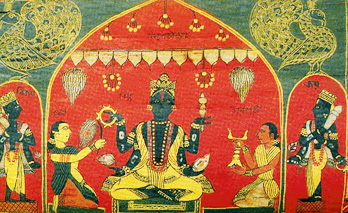 |

